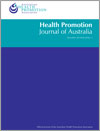
Health Promotion Journal of Australia
Volume 24 Number 3 2013
HEv24n3_EDAre there more positive alternative celebration opportunities to Schoolies Week?
HE13082Building health promotion capacity in a primary health care workforce in the Northern Territory: some lessons from practice
Workforce development is critical for reorienting health services. Health promotion specialists play an important role in reorienting practice, which is only effective when combined with other strategies and driven and led by the primary health care workforce themselves. Participatory action research is a useful tool in this process.
HE13094Academic and personal problems among Australian university students who drink at hazardous levels: web-based survey
Australian university students consume large amounts of alcohol. There is little published information about personal and academic problems associated with this behaviour. We sought to estimate the prevalence, and identify variables associated with, alcohol-related problems among undergraduate hazardous drinkers through a web-based survey. We found a high prevalence of preventable alcohol-related problems and impacts on academic performance and suggest universities have a duty of care to make greater efforts to address hazardous alcohol consumption.
HE13040Views of pregnant women in South Western Sydney towards dental care and an oral-health program initiated by midwives
This study describes the views of pregnant women in Australia towards dental care and midwives promoting oral health. The survey results showed that few women were consulting dentists despite a high prevalence of dental problems, with the main barriers being lack of dental awareness, safety concerns and dental costs. Most women were receptive to midwives promoting oral health and referring them to affordable dental services. Future strategies to improve maternal oral health should explore using midwives to increase dental awareness and providing affordable dental referral pathways.
HE13047The vocational education setting for health promotion: a survey of students’ health risk behaviours and preferences for help
This study assessed the prevalence of health risk behaviours and preferences for health promotion programs among 224 Australian community college students. Participation in multiple health risk behaviours was high. The tertiary education and workplace training setting represents an opportunity for early intervention into risky health behaviours among young adults.
HE13045Can small stores have a big impact? A qualitative evaluation of a store fruit and vegetable initiative
The aim of this evaluation was to explore the quality, barriers, enablers and outcomes of a retail fresh fruit and vegetable initiative in rural communities identified to have poor geographic access to healthy food. It was found that effective leadership and communication from project workers, a range of retail incentives and the capacity of the store to promote, stock and sell fresh fruit and vegetables influenced perceived success. Fruit and vegetable retail initiatives in small rural community stores may have a role in supporting consumption of fruit and vegetables.
HE13041Young adult perceptions of Australia’s physical activity recommendations for adults
Physical activity recommendations for adults advise regular participation in moderate-intensity physical activity, such as walking. Despite reporting walking for transport and leisure, interviews with young Australian adults revealed that they focus on fitness benefits associated with high-intensity physical activity and consider walking of insufficient intensity to achieve any health or fitness benefits.
HE13054Physical activity levels during pregnancy and gestational weight gain among women who are overweight or obese
In women who were overweight or obese, physical activity declined significantly between early pregnancy and 36 weeks gestation, before increasing after birth. Physical activity at 4 months postpartum remained lower than that in early pregnancy. Women with higher BMI had a greater decline in physical activity over pregnancy.
HE13054 Abstract | HE13054 Full Text | HE13054PDF (284 KB) Open Access Article
HE13066Edible gardens in early childhood education settings in Aotearoa, New Zealand
A study of the presence and role of edible gardens in Early Childhood Education Services has found that gardens are already being used as a versatile teaching tool in many settings. Most are new, needing support among teachers and parents to be able to maintain these resources for future generations.
HE13073Sitting time, physical activity and cervical intraepithelial neoplasia in Australian women: a preliminary investigation
This preliminary investigation studied the relationship between sitting time, physical activity and the risk of cervical intraepithelial neoplasia. The risk, as indicated by abnormal Pap smear status, was found to be significantly associated with prolonged sitting. Women should be encouraged to reduce their sitting time and remain physically active.
HE13073 Abstract | HE13073 Full Text | HE13073PDF (121 KB) Open Access Article
HE13055A randomised controlled trial of an active telephone-based recruitment strategy to increase childcare-service staff attendance at a physical activity and nutrition training workshop
Although staff training is key to the implementation of obesity prevention programs in childcare services, little is known regarding how to maximise staff training participation. We found that a telephone-based active invitation strategy increased the proportion of staff attending training, compared with invitation via newsletters only. Active invitation strategies, including follow-up telephone calls, should be used to invite staff to training so that childcare service staff can be best equipped to deliver obesity-prevention programs.
HE13062Key influences on motivations for utility cycling (cycling for transport to and from places)
This qualitative study examined the main motivators for utility cycling (cycling as a means to get to and from places). The findings indicate that the built and social–cultural environments need to be more supportive of utility cycling before even current cyclists will be motivated to engage (more often) in utility cycling. Additional government strategies and more and better infrastructure that support utility cycling beyond commuter cycling may encourage a utility cycling culture.

